|
Background
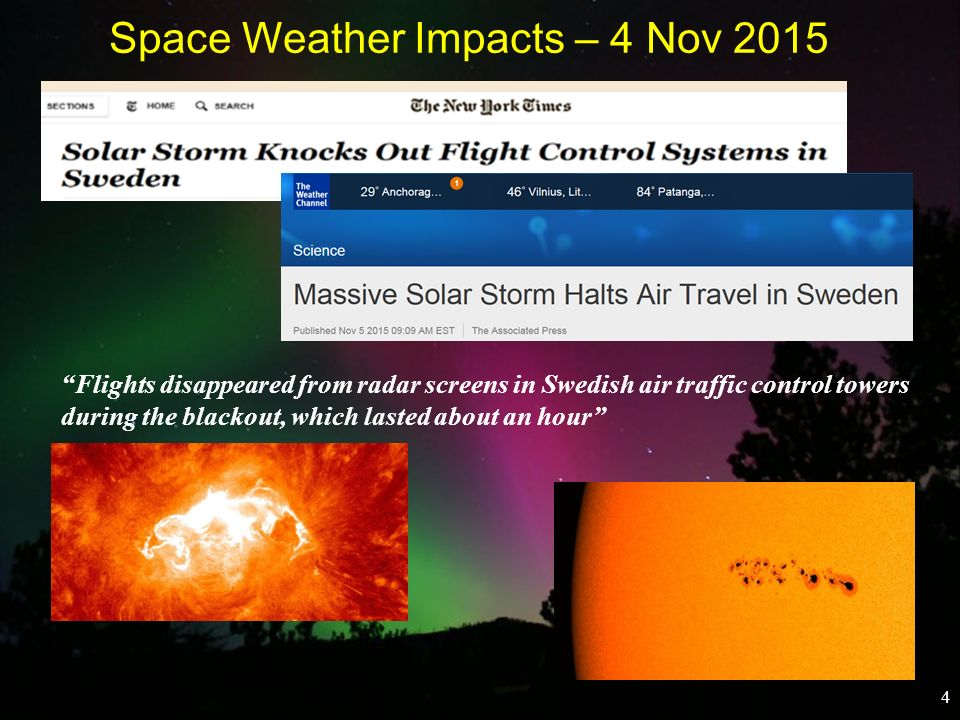
The interaction of solar activity with the Earth's upper atmosphere occurs through a complex series of events often referred to as Space Weather (SW). Our star, the Sun, plays an important role in determining SW, because the Sun’s own atmosphere, which begins from the visible solar surface called the photosphere, extends to the path of Earth. From a constant stream of particles in the form of solar wind to more energetic solar flares (M and X-class) and fast Coronal Mass Ejections (CMEs), all stemming from solar activity, various solar events can have a major impact on life on Earth and on our modern high-tech based devices in space or on Earth. The image above demonstrates by newspaper headlines the major public interest in solar storms and their effects, e.g. that took place on 4 Nov 2015 causing the shutting down of the Nordic Airspace. The lower left inlet captures the explosion on the solar surface, while the lower right inlet is the associated magnetic field concentration that is so much key to these events.
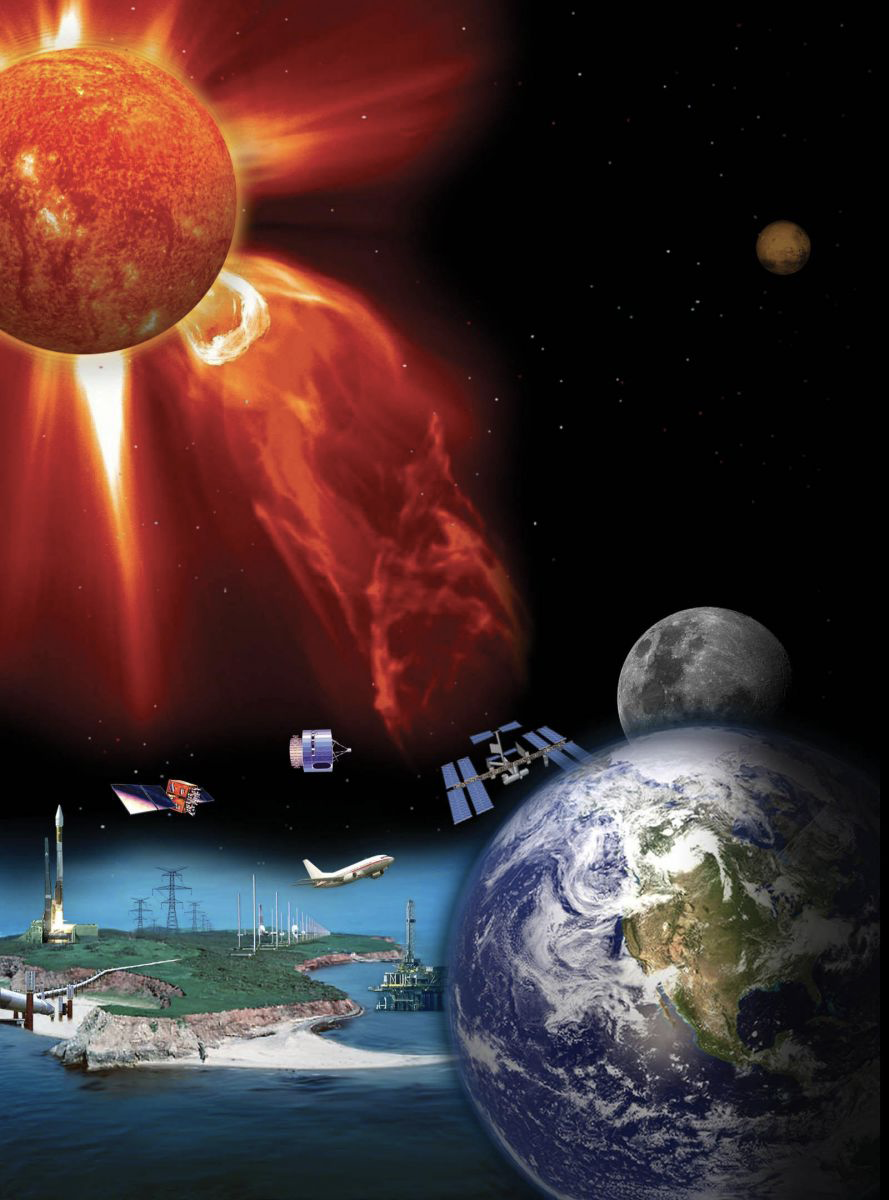
Space Weather was born as a concept thanks to the so-called Carrington event. On 1st of September in 1859, R.C. Carrington and R. Hodgson, while carrying out routine sunspot observations at different locationa, both witnessed a major optical flare.
Carrington [1859] reported that this huge solar event caused a strong geomagnetic storm only 17 hours and 40 minutes later. Auroras were sighted down to as low as 20 degrees geomagnetic latitudes (e.g. even in Cuba or Mexico), and electric surges occurred from ground-induced currents in telegraph wires, both in Europe and the USA.
Would such flare event occur these days, it may set back our civilisation years if not decade by the damaged it may cause to our high-tech, chip-driven world. On the left, there is an artistic visualization of what space, e.g. satellites, and ground-based services from aviation to power lines, etc. would be damaged or affected very seriously.
Today, one of the main questions of solar plasma-astrophysics research is to understand clearly the causes and the underlying dynamics of SW phenomena. The ultimate goal of our SAMNet project is to develop a reliable forecasting facility and deliver an accurate flare and CME prediction to protect mankind with its modern and sophisticated technology-base that might be at considerable risk from radiation and high-speed charged particles blowing often abruptly off the Sun.
The question is not anymore whether, but when a devastating flare/CME event may happen. Humanity must be ready to protect itself. Major international funding bodies, e.g. NASA, NSF or the EU's Horizon 2020, all consider it a high priority issue in their research strategy agenda to reliably and accurately predict and protect from Space Weather events in our era of human space exploration. A crucial different between today's world and the one from centuries ago is that we are now substantially more reliant upon computers and telecommunications to run our commerce, global GPS-based work and transport facilities, and even our forms of entertainment and recreation. The initial 15 communication satellites in space back in 1989, nowadays, have been joined by more than 500 other satellites. Mobile phones, computers, banking sector, aviation, defense, maritime, support services, and the internet have all become an industry worth several billions of pound to protect it from space hazards.
Societal Impact
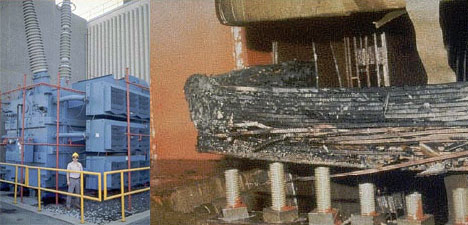
The Sun is the main driver of adverse space weather that causes substantial socio-economic impact at Earth. This includes both direct effects on specific industry sectors (such as electric power, spacecraft, communication and aviation industries) and indirect effects on dependent infrastructures (such as positioning and navigation systems, oil/gas pipelines, banking and the general financial services).
The image above is taken after a space weather storm has caused the burn-down of a major electric power distribution station in Quebec, Canada, resulting in for hundreds of thousands of households not having even elementary electricity supply for an extended period causing millions of loss in revenue. Further, more recent examples are, e.g., at the end of April 2017, a space weather event knocked out power grids across the entire country in the USA in one simultaneous fashion. San Francisco, New York, and Los Angeles all experienced challenges or shutdowns in basic infrastructures such as communication networks and mass transportation. In September 2017, space storms disrupted shortwave radio communications for hours preventing emergency response to hurricanes tearing apart the Caribbean.
The threat-assessment report by Lloyd’s insurance [2013] concluded that extreme space weather events would cause $2.6 trillion damage (>10 times that of the most destructive hurricanes and earthquakes), and it would take between 4 and 10 years to fully recover. More recently, examining disruption to the global supply chain, Eastwood et al. [2017] estimated a similar total economic loss up to $2.7 trillion. Kataoka [2013] estimates a probability of 4–6% for such a superstorm occurring within the next decade, while Riley [2012] raises this probability to ~12%. Superstorms aside, however, even the ‘nominal’ space weather causes an economic loss of 10 billion €/year (National Research Council report, 2008; Schrijver et al. 2014). Also, as outlined by the UK Govt. National Risk Register and the US Dept. of Homeland Security’s National Space Weather Strategy Plan, such strong space weather events that impact the Earth may cause potentially extreme setbacks on timescales of years to decades.
What could be the ultimate solution?

With our proposed Solar Activity Monitor Network’s (SAMNet’s) cutting-edge Magneto-Optical Filter (MOF) technology (see a schematic summary of the MOF cell on the left), space weather impacts will be substantially mitigated down to a potentially insignificant scale. We propose to construct a network of ground-based solar telescopes that would monitor continuously the Sun’s magnetic field.
Observed solar data flowing in from the network stations to its headquarter at Gyula Bay Zolatn Solar Observatory (GSO), operated by SAMNet Consortium, lead by the Hungarian Solar Physics Foundation, will be analysed in real-time and hourly forecast warning will be issued.
Italian and UK industries (e.g., Andor, Dal Sasso slr and PES Ltd) will be involved to construct the full Solar Activity Magnetic Monitor (SAMM) master station based at GSO and the estimated 12+ replica stations worldwide. With our industrial partners, we will investigate options for establishing a European-based (ideally, Italy) commercial manufacturing centre of MOF cells. The proposed socio-economic breakthrough will deliver, for the first time, the foundations of an integrated space-weather prediction service to mitigate the destructive consequences of space weather.
Why we?
There are already existing space weather services, e.g. at https://www.swpc.noaa.gov/ or http://www.spaceweather.gc.ca/index-en.php, however, none of these services provide the much needed reliable lead time. After consulting with various stakeholders (e.g. Pentagon, Airbus, UK Maritime, various insurance sectors, etc.) the customer expectation would be to deliver a high-fidelity forecasting with about 2-3 days of lead time, but ideally even up to 5 days. This latter can be achieved only from space, with an appropriate satellite system set up in e.g. the L5 point, and, the construction would cost of the order of €500M. Even if such a dedicated satellite network is constructed, the additional costs of operation are non-negligible. There are also the permanent rather high risks of the satellites themselves being damaged by interplanetary debris or solar eruptions where the replacement would take considerable resources and time.
Further, although the currently available satellites do provide valuable solar magnetic data that are useful for space weather monitoring, these satellites are designed for scientific measurements and not for space weather services, with a customary lifetime of about a couple of years. It also needs to be emphasised that telemetry is another serious issue and at present there is no clear solution how to come around this problem, even if a space weather monitoring satellite service system is constructed.
On the other hand, a dedicated ground-based system, e.g. a network of solar observatories, delivering continuously even up to at minute temporal resolution solar LoS magnetic data, stationed around our Globe would not suffer from telemetry issues and shortages, and could be realised for a fraction of the costs that of an equal calibre satellite system.
Why our model?
There already exist a number of scientific approaches that attempt to predict flares and CMEs. Most of them rely on measuring various aspects of the solar magnetic fields and can deliver forecasting up to about 6-10 hrs with relatively high fidelity.
However, our model is using one particular and a very novel aspect that none of the others models do:
- We use solar magnetic data measured not just at the solar surface, called the photosphere, but with our MOF-based technology solution we will measure the line of sight (LoS) component of the magnetic field as function of height in the lower solar atmosphere.
- We will have high-cadence LoS magnetic data from the photosphere, throughout the low chromosphere up to about 2000 km above the solar surface, i.e. potentially in the low corona.
This is a genuinely true and revolutionary step forward, as such data will allow (as demonstrated in the scientific literature by e.g. Korsos et al. 2015, 2016, 2018a,b,c) to improve the forecasting lead time up to a day with high fidelity, while even up to 48 hrs with reliability that still has a high market value for the various stakeholders (from aviation, defence to banking or GPS services). The concept is expanded in more details in the section on the scientific case below.
Project outline
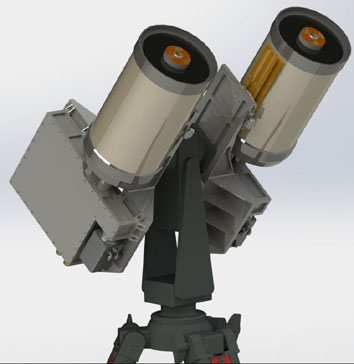
SAMNet is an international network of planned individual SAMM stations (see left the image of the sample of the actual telescope design where the solar magnetic monitor telescope is made of a single-mount, dual, 23 cm aperture optical telescope assembly (OTA) solution, each having its own MOF sensor to detect the solar magnetic field at distinct heights in the solar atmosphere.
Each OTA will be able to measure the LoS component of the magnetic field at various regions of the solar chromosphere, therefore providing very precise, seeing-limited real-time information about the structure of the magnetic field at the source regions of solar storms.
Our prediction method, called the WG_M method in the scientific literature, will exploit these data to provide flare forecasting with unprecedented prediction lead-time and accuracy.
Since the stations will be positioned around the Earth (see the proposed station map below with the blue stars indicating the loci of stations), at each location there will be an additional gain in the lead-time, depending on the maximum difference in local time zone of a given station and that of the farthest station. E.g., in the case of Europe, beside the scientific lead-time already offered by the novel concept of WG_M applicable across the solar atmospheric heights, there will be an additional 18 hrs of lead-time benefit if SAMNet data from e.g. Colombia or Hawaii are used. This is an absolute novel progress!
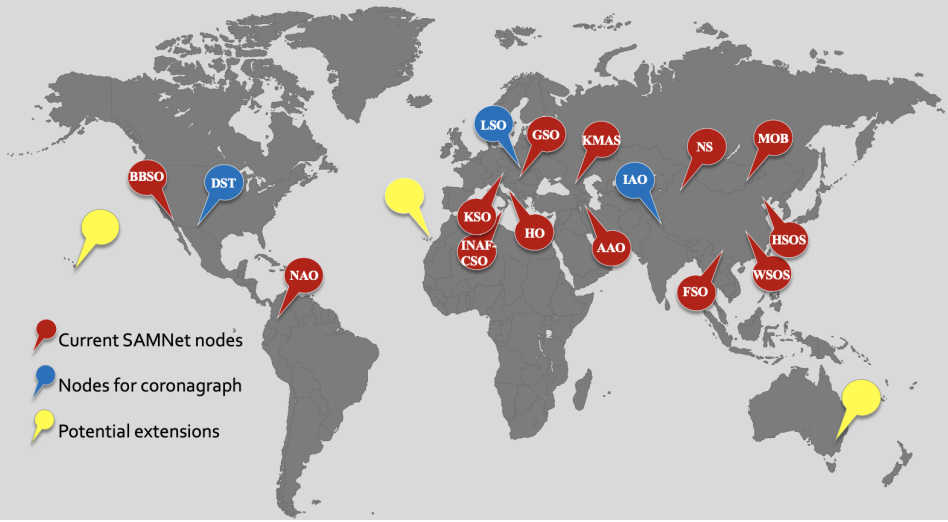
An international consortium of 22 partners from academia and industry has been formed to develop
- a fully-robotic solar telescope system that incorporates MOFs and
- associated flare/CME forecast data-processing algorithms. Each SAMM station will have a single mount and four 23 cm-aperture optical tube assemblies (OTAs), hosting MOFs that measure the line-of-sight (LoS) component of the magnetic and velocity fields at four heights in the lower solar atmosphere.
Stations will reside in a wide range of Earth’s longitudes, providing suitable coverage for reliable and timely space-weather warnings to be issued. SAMNet will bring the lead time of flare/CME forecasts up to a day scale, something that is highly desired by various industry sectors (e.g., aviation, communication, satellite, insurance).
Scientific case
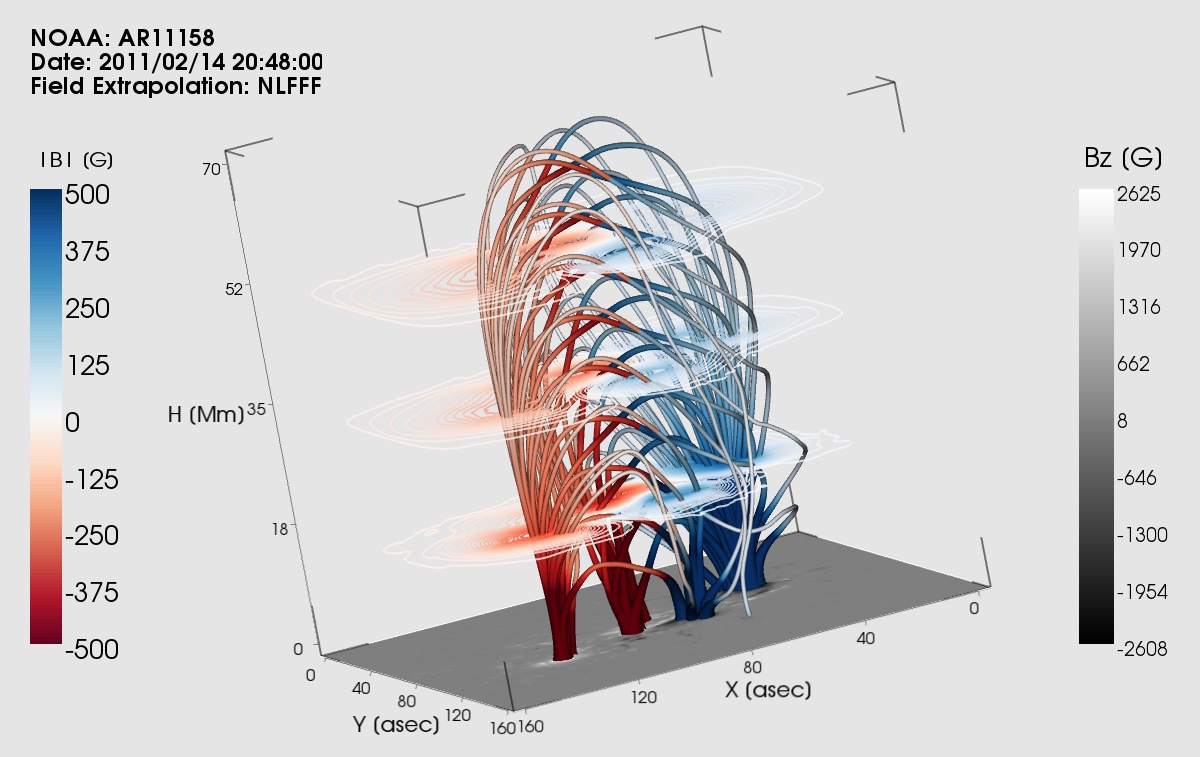
Key drivers of space weather are abrupt and powerful flares and CMEs, which are the largest eruptions in the entire solar system. Predicting solar flares and CMEs is particularly challenging, yet is needed to mitigate their adverse and potentially devastating effects. Flare prediction methods, recently developed by our consortium members (see left the constructed magnetic skeleton,, using data available for proof-of-concept), have demonstrated, through observations and high-performance computer simulations (see, below, a snapshot of a simulated emerging solar explosion), that information on the magnetic field at various heights in the lower solar atmosphere (in particular, the chromosphere) has the potentials to dramatically improve forecasting lead time.
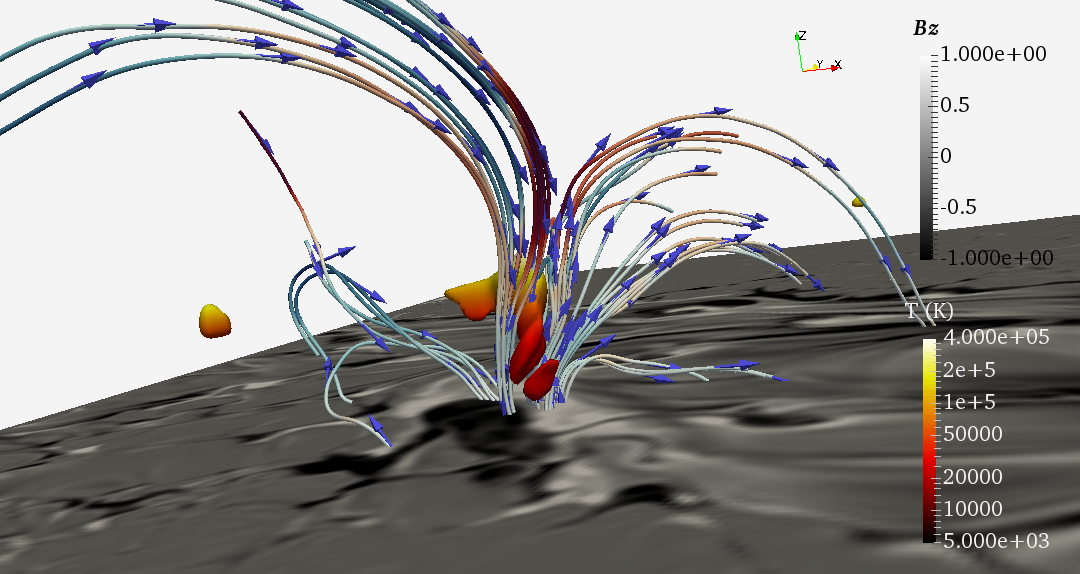
Therefore, a facility is needed to provide routine and continuous supply of magnetic field information of solar active regions at various atmospheric heights. With our key industry and academic partners, a proof-of-concept robotic SAMM telescope has already been designed, built and commissioned with 2 OTAs (using K I and Na I D MOFs). However, if we wish to improve our forecasting capabilities for timescales of days (that is highly desired by industry), we need LoS magnetic field data at additional chromospheric heights. We propose a leap to develop SAMM to its full capacity by adding 2 more MOF lines (Ca I and He I) for the measurement of chromospheric magnetic fields that are needed to predict the onset of flares and CMEs with high precision.
The scientific breakthroughs will include:
- fundamentally understanding how the lower solar atmosphere is connected magnetically, dynamically and energetically to the overlaying atmosphere;
- vastly improving the prediction of solar flare/CME onset prediction, providing a reliable and accurate probability of solar eruptions; and
- understanding solar eruptions by combining the improved knowledge of magnetic fields with synoptic observations and simulations.
The enabling technological breakthrough will be the application of MOF filters in a network of easiy-to-deployable, remote-controlled solar observatories that image the solar atmosphere at four independent heights and provide 3D tomography of solar atmospheric magnetic fields.
Leadership & potential team members With initial start-up help and support from Italy (~€1M), Hungary as well as from the UK (via STFC, U of Sheffield and QUB), the construction of the first dual-channel SAMM telescope has already been initiated (see left). This fully-robotic instrument is hosted at Gyula Bay Zoltan Solar Observatory thanks to a decade-long agreement of in-kind support secured for this purpose by the Local Govt. of Gyula (Hungary). A fully-robotic dome was built and that now hosts the SAMNet master station and associated initial data processing and computing facilities/storage (currently with 64TB capacity).
Following this initial proof-of-concept demonstration, SAMNet was formed and it is now continuously expanding, with strong additional international expertise (e.g., Met Office, MSSL from UK; partners who have expressed strong support and desire for involvement include institutions located in: Austria, China, Colombia, Croatia, Georgia, Hungary, India, Italy, Russia, Slovakia and the USA). The ultimate goal is to have a SAMNet station in each time zone, with the UK retaining scientific and Hungary operational leadership.
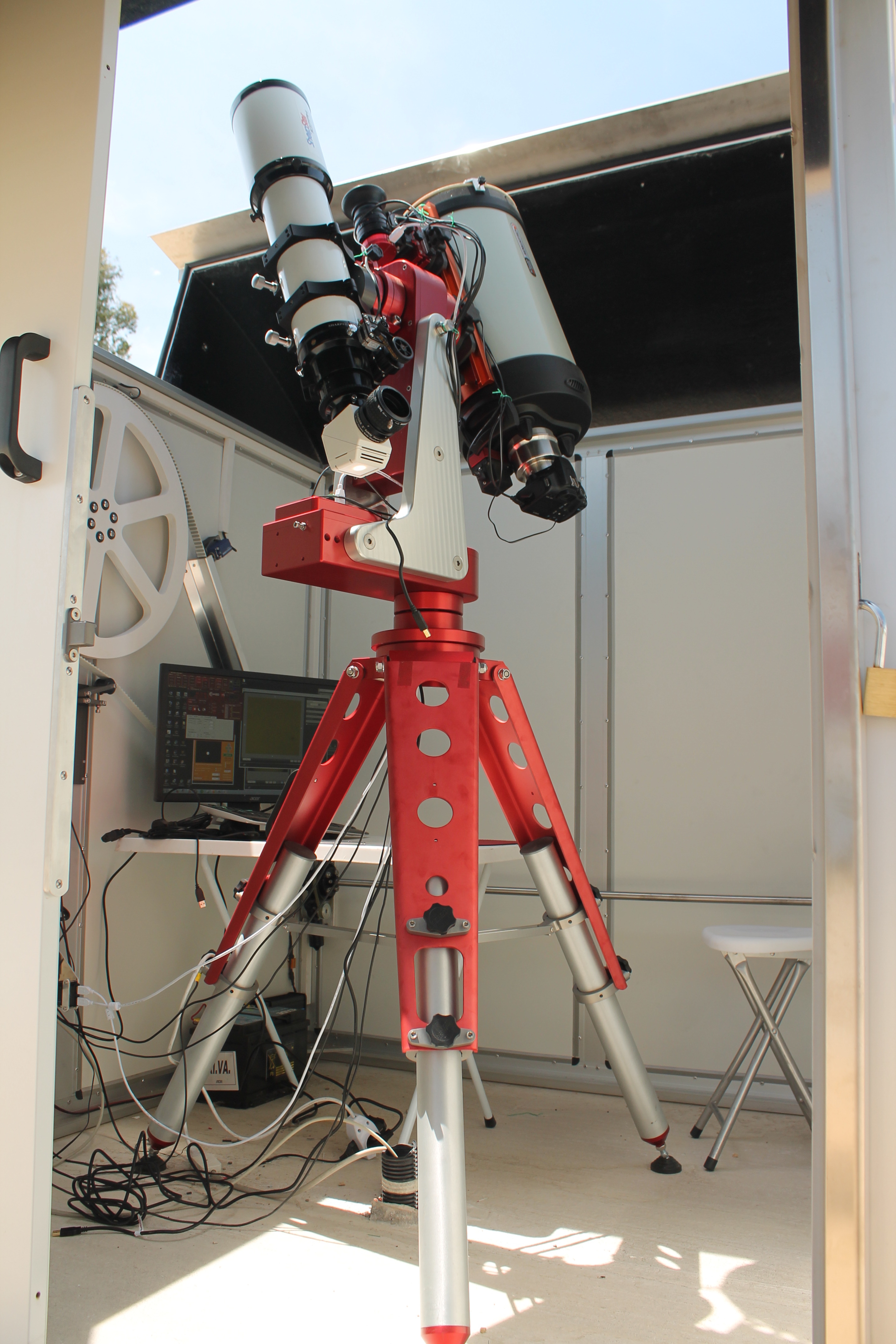
Participating obervatories:
- Abastumani Astrophysical Observatory (AAO) on Mount Kanobili (Georgia);
- Big Bear Solar Observatory (BBSO) in the San Bernardino Mountains in southern California (USA);
- Fuxian Solar Observatory (FSO, Yunnan, China);
- Huairou Solar Observing Station (HSOS, Huairou, China);
- Mingantu Observing Base (MOB, Inner Mongolia);
- Nanshan Station (NS) of Xianjiang Astronomical Observatory (Xinjiang, China);
- Wuhan Solar Observing Station (WSOS, Wuhan, China);
- National Astronomical Observatory (NAO, Colombia);
- Gyula Bay Zoltán Solar Observatory (GSO, Hungary);
- Hvar Observatory (HO, Zagreb, Croatia);
- Indian Astronomical Observatory (IAO, Merak, India);
- INAF - Catania Astrophysical Observatory (INAF-OACT, Italy);
- Kanzelhöhe Observatory for Solar and Environmental Research (KSO, Austria);
- Kislovodsk Mountain Astronomical Station (KMAS) of the Pulkovo Observatory (Russia);
- Lomnicky Stit Observatory (LSO, Slovakia);
- Sunspot Solar Observatory (SSO, USA);
- Ulugh Beg Astronomical Institute of Uzbekistan Academy of Sciences, (UBAI, Uzbekistan)
- South African National Space Agency (SANSA)
Scale of investment
Securing leadership in the SAMNet project would fall in the small-to-medium-scale range of investments.
It is estimated that fully constructing the 4-channel prototype station would cost ~£1.5M and the operational cost for a period of 10 yrs would total ~£1-2M, including periodic upgrades of the MOF cells.
It is anticipated that various industry sectors (e.g., aviation, maritime, insurance, etc.) would contribute both to the detector construction (MOF cell realisation) and operational phases in return for a first come first serve based.
It is expected that each SAMNet node will independently raise funding in order to construct their own SAMM station(s) and cover the costs of operation for their local node(s).
On average, the cost to each international SAMNet node is expected to be ~£0.2-0.5M for the construction phase depending on the local logistics arrangements.
|
















